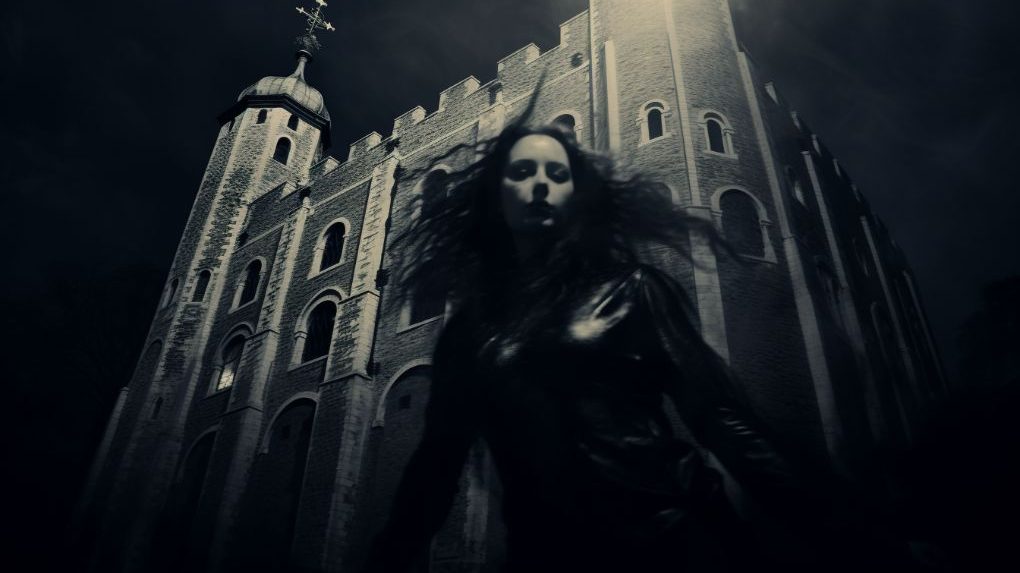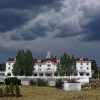In the heart of the bustling city of London, a monument to royal power and death stands as a grim reminder of the days of power struggles, bloodshed, and haunting secrets.
A place where the walls whisper the tales of the dead, echoing the grim stories from centuries past. The Tower of London, a mighty fortress that has witnessed the rise and fall of monarchs, stands as a living testament to the darker chapters of England’s history. This fortress, with its defensive walls towering over the River Thames, has a history drenched in blood and betrayal, with tales that can chill anyone to the bone.
Tower of London History: A Prelude to Blood and Power
Nestled on the north bank of the River Thames, the Tower of London’s history is as old as the city itself. Founded towards the end of 1066 by William the Conqueror, the first White Tower served as a demonstration of the Norman’s imposing power over the English lands. As the tower expanded, so did its dark history, intertwining with tales of betrayal, death, and haunting sorrow. Contemporary chroniclers would come to document the tower’s many unsettling narratives, tales that continue to echo through the centuries.
In its early years, the tower served as a royal residence, an emblem of royal power and might. A place where the kings and queens of England sought to safeguard their royal possessions, including the infamous Crown Jewels. But as much as it was a symbol of royal grandeur, it was also a site of anguish and death. The fortress witnessed the fall of many influential figures, with some meeting their gruesome end within its cold, stone walls.
As time went on, the tower transformed from a royal palace into a place of imprisonment and execution. A place where individuals, including members of the royal family, were held captive, sometimes meeting their end in the most gruesome of manners. Within these walls, the cries of the tortured and the condemned resonate, leaving a permanent stain on the tower’s history.
The tower’s gruesome legacy began to take shape during the reigns of kings like Henry VI and Edward IV. It was during this time that the tower became a place of unspeakable horrors, with bloody events that would mar its reputation forever. From the mysterious disappearance of the young princes to the beheading of Anne Boleyn, the tower became synonymous with death and despair.
As we delve deeper into the tower’s history, prepare yourself to journey through tales of ghostly appearances and cries that echo through the night. Uncover the dark secrets that lie within the Bloody Tower and the horrifying tales of the royal family members who met their end in the most tragic of circumstances. In this unnerving narrative, we will venture into the very bowels of the tower, where the ghosts of the past continue to haunt its present.
The Royal Palace: Luxurious Lodgings and Dark Secrets
Nestled amidst the sprawling grounds of the historic royal palaces, the royal palace within the Tower of London epitomized opulence and grandeur. Yet, its luxurious lodgings bore witness to countless tragedies, treacheries, and unspeakable horrors that unfolded within its chambers. Once a residence adorned with the finest embellishments of the time, the royal palace harbored dark secrets, whispered amongst the courtiers and yeomen warders who tread its halls even today.
Under the reign of Henry III, the tower underwent massive expansions transforming into a grandiose royal residence, a place where celebrations intertwined with whispered conspiracies. Magnificent banquets held in the grand halls were often followed by clandestine meetings where plots of murder and deceit were hatched. Here, the haunting strains of music from lavish parties echoed with the silent cries of those who fell victim to the merciless intrigues of the royal court.
As you traverse the halls of this medieval palace, one can almost hear the murmurs of ghosts of nobles and servants alike, their stories intertwined in a grim tapestry of history. The windows which once offered views of the sprawling gardens now seem to frame the faces of the dead, a chilling reminder of the many lives claimed within these stone walls.
The Haunting of the Bloody Tower
Walking further, we arrive at the Bloody Tower, a place where the air is thick with the weight of history, where the very stones seem to weep with the blood of the innocent. Here resided the princes, Edward V and his younger brother Richard, Duke of York, known famously as the “Princes in the Tower”. Entrusted to the care of their ambitious uncle, the future Richard III, their young lives were cut tragically short, their bodies reportedly buried within the tower’s walls.
The two towers that held them have become synonymous with death and betrayal, their stories echoing through time, stirring the hearts of those who dare to listen. Witnesses report seeing the ghostly figures of the two princes, wandering hand in hand, their faces pale and their eyes filled with an eternal sadness. It is said that their innocent spirits still roam, trapped within the very walls that witnessed their untimely deaths.
The Bloody Tower is not only home to the lost princes but also to countless others who met their end within its confines. From the ruthless imprisonment of Guy Fawkes to the beheading of Anne Boleyn, the tower reverberates with the cries of those who once lived and died here. The bloody tower, a place of sorrow and death, stands as a chilling testament to the brutal history of England’s royal family.
Crown Jewels: The Glistening Heart of the Fortress
In the core of the formidable tower lies a chamber holding England’s most prized and revered treasures – the Crown Jewels. This resplendent collection, including the Imperial State Crown, embodies the very essence of royal power and grandeur. But amidst the sparkle and allure, dark tales lurk in the shadows. Legends whisper of curses that befell those who dared to misuse these precious artefacts, weaving a web of greed, betrayal, and tragic fates.
The Crown Jewels were not merely symbols of royal power, but also a beacon attracting greed and deceit. Numerous attempts were made to seize them, leading to brutal punishments and executions. Here, in the Waterloo Block, the dazzling gems silently narrate tales of those who fell victim to their mesmerizing allure, their lives ending in darkness and despair.
Unsettled Spirits of the Royal Family
As we venture further, we stumble upon the eerie tales surrounding the very monarchs who once graced these halls. The Tower has been a silent witness to the downfall of many a member of the royal family, their spirits said to linger in despair, unable to find peace. Queen Anne Boleyn, beheaded under the orders of her husband King Henry VIII, is perhaps the most famous phantom resident. Her ethereal figure has often been sighted, wandering the chapel of St Peter ad Vincula, her head tucked under her arm, a silent testament to her tragic end.
Another haunting presence is that of Lady Jane Grey, the Nine Days Queen, who met her death at the young age of 16. Witnesses claim to have seen her mournful figure wandering the battlements, her ghostly visage forever marked by the fear and sorrow of her final moments.
Yet, not all the spirits are of those who met gruesome ends. Within the Queen’s House, a more benign presence is felt, believed to be that of the gentle King Henry VI. His spirit is said to return to the very spot where he met his end, marking the anniversary of his death with a solemn vigil, a king in eternal mourning.
Related: Behind the Scenes of the Stanley Hotel: A Haunted History
The White Tower: A Monument to Death and Power
As we delve deeper, we arrive at the White Tower, the oldest part of the complex, a symbol of royal power and dominion. Yet, its grandeur hides a history marred by death and cruelty. Within these walls, countless souls met horrifying fates, their screams echoing eternally through the stone corridors. The infamous White Tower, a place of dread, where the line between the living and the dead blurs, and the past seeps into the present, tormenting those who dare to visit.
Whispers from the Wakefield Tower
Venturing further, we find ourselves in the Wakefield Tower, a place echoing with the whispers of the dead and the tortured. This part of the tower, once a royal residence and later a prison, resonates with the anguished cries of King Henry VI, who met a tragic end here. It’s believed that every year, on the anniversary of his murder, the king’s ghost returns to Wakefield Tower, filling the halls with heart-wrenching sobs that echo through the cold stone walls.
But the tragic king isn’t the sole spirit haunting this place. Many prisoners were kept in squalid conditions here, their despair permeating the very stones, leaving an imprint of sorrow and pain that visitors claim to feel even today.
Royal Armouries: Echoes of Battles Past
Next, we arrive at the Royal Armouries, housing a vast collection of weapons and armour, each piece telling a story of bloodshed and warfare. This place reverberates with the sounds of battles past, the clang of swords, and the cries of fallen soldiers. Visitors have reported hearing phantom battles, a chilling reminder of the violent history that these walls have witnessed.
As you wander through, you may feel an eerie presence, as if the spirits of ancient warriors are watching, their restless souls still yearning for battle, unable to find peace in the afterlife. The air here is thick with the weight of history, an unnerving reminder of the brutality and violence that once reigned supreme within these walls.
Royal Mint: Currency and Cruelty
Further into our journey, we encounter the Royal Mint, a place of wealth and power, but also one of cruelty and exploitation. Tales of workers enduring horrific conditions, coupled with accounts of ruthless punishment, paint a dark picture of the past. In this place, the relentless pursuit of wealth overshadowed humanity, leaving a legacy of suffering and death.
The Royal Mint, while a symbol of England’s economic prowess, also stands as a reminder of the cruelty and inhumanity that marred its history. The whispers of the exploited still seem to linger in the air, a chilling testament to the darker aspects of England’s past.
Indeed, we proceed deeper into the tale, immersing ourselves in stories that send chills down one’s spine, echoing the darkness and dread that the tower harbors in its ancient walls.
The Menagerie: A Savage Display of Royal Power
In an era long past, the Tower housed a menagerie of exotic beasts, a testament to the royal power and might. Lions roared in the Royal Menagerie, their majestic roars resonating with a brutal display of royal authority. Polar bears from distant lands swam in the River Thames, a bizarre yet terrifying spectacle of the royal family’s extensive reach.
Yet, the Menagerie was no sanctuary. It was a place of cruelty and violence, where beasts from different continents were confined in cramped, unnatural spaces, met with cruelty at every turn. This dark chapter in the tower’s history saw animals suffering in silence, their agonized roars echoing through the ages, a haunting reminder of the savage displays of power that once held court here.
St. John’s Chapel: The Silent Witness
Within the heart of the White Tower, lies the St. John’s Chapel, a silent witness to centuries of royal ceremonies and somber events. Here, amidst the sacred silence, whispers of ancient prayers mingle with cries of despair. Visitors report an unsettling stillness, a heaviness that envelops them as they step into the chapel. It is as if the very walls bear the weight of countless secrets, stories of betrayal and bloodshed that reverberate in the echoing footsteps of those who venture here.
As you walk through, you might feel a shiver, a sudden chill, as though the spirits of the past reach out, seeking solace, yearning to share their tales of sorrow and loss. The chapel stands as a beacon, a place where the spiritual meets the sinister, where the echoes of the past resonate with a haunting, ever-present silence.
You may also like The Haunted Whaley House: A Look into its Dark Past
The Tower Hill: A Ground of Sorrow and Death
Next, we find ourselves at Tower Hill, a place that witnessed the cruel fate of many who fell out of favor with the crown. A site of public executions, Tower Hill became a theater of death, where the air is thick with the cries of those who met their end in the most gruesome ways.
From Thomas More to Thomas Cromwell, numerous individuals have faced the executioner’s axe here, their last moments a horrifying spectacle for the crowds that gathered. Today, it is said that the ground remembers, retaining the anguish and fear, an eternal testimony to the brutal events that transpired here. Visitors speak of an overwhelming sense of dread, a palpable energy that seems to seep from the very earth, a haunting reminder of the brutal history that Tower Hill beholds.
The Princes: Lost Innocence in the Heart of the Tower
In the tower’s dark history, few tales are as heartbreaking as that of the young princes, Edward and Richard. Their innocent lives, snuffed out in the pursuit of power, cast a dark shadow that seems to permeate the very stones of the tower. Visitors often report feeling an overwhelming sense of sorrow as they explore the areas where the princes were last seen alive.
Their uncle, the future Richard III, has long been suspected of orchestrating their deaths to seize the throne for himself. The haunting eyes of the princes seem to follow visitors, a silent plea for justice, their spirits unable to find peace until the truth of their untimely demise is brought to light.
Windsor Castle: Echoes of Royalty Past
Though slightly distanced from the main tower, Windsor Castle’s history is intrinsically linked with the Tower of London. Many of the individuals who met tragic fates at the Tower had once graced the halls of Windsor, their spirits said to roam both places, forever trapped in a loop of their final, terrifying moments.
At Windsor, the air seems to hold whispers of royal gatherings, intrigues, and betrayals that marked the reigns of monarchs over centuries. Visitors have reported encountering apparitions, echoes of a time long past, yet vividly alive in the haunting atmosphere that envelopes Windsor Castle.
Westminster Abbey: Where History Meets the Supernatural
Much like Windsor Castle, Westminster Abbey has witnessed the rise and fall of monarchs, their histories intertwining with the Tower of London. This place, a site of coronations and royal weddings, also holds a darker, more sinister energy.
Numerous visitors have recounted chilling encounters, visions of past events replaying before their eyes, spectral figures roaming the corridors, a tangible reminder of the turbulent and often violent history that marked England’s royal lineage.
The Yeomen Warders: Guardians of the Tower’s Dark Secrets
The Yeomen Warders, also known as the Beefeaters, have been the guardians of the Tower for centuries. Entrusted with protecting the Tower and its secrets, these individuals carry the weight of history with them. Their tales, passed down through generations, are filled with ghostly encounters and eerie experiences, a testament to the Tower’s haunting energy.
From spectral figures seen wandering the grounds to unsettling whispers heard in the dead of night, the Yeomen Warders are privy to the Tower’s darkest secrets, their stories adding another layer to the chilling tales that make up the Tower of London’s haunted history.
Also read Is Lucid Dreaming Dangerous? – What You Need To Know Before Trying It Out
A Walk Through the Medieval Palace: Echoes of Past Grandeur
In the heart of the tower complex lies the remnants of the once grand Medieval Palace, a testament to the Tower’s role as a royal residence. Visitors walking through these grounds can almost hear the whispers of the ancient nobles who once graced these halls, their lives a complex tapestry of power plays, betrayal, and sometimes, tragic ends.
But it isn’t just the whispers of the living that echo through these historic walls. Visitors have reported feeling unseen hands touching them, breaths against their necks, and the sudden drops in temperature, as if the spirits of the past walk among them, sharing their space with beings not of this world.
Anne Boleyn: A Queen’s Tragic End
Among the spectral figures said to haunt the Tower, none is more famous than Anne Boleyn, the ill-fated second wife of King Henry VIII. After a swift and arguably unjust trial, she was executed within the Tower grounds. Today, her restless spirit is often seen wandering near the chapel of St Peter ad Vincula where she was buried, or at the Tower Green, where she met her tragic end.
Reports claim her apparition appears without a head, a constant, chilling reminder of the brutal way her life was cut short. Visitors and Yeomen Warders alike have recounted encountering her spectral figure, a tragic yet fascinating glimpse into the life and death of a queen who once held the heart of a king and the future of a nation in her hands.
The Unsettling Mystery of the Two Towers
Within the tower complex, the haunting mystery of the two towers – the Bloody Tower and the Wakefield Tower, engulfs visitors in an aura of dread. These towers, associated with imprisonment, torture, and death, seem to retain the dark energy of the events that transpired within their walls.
People have reported hearing the sounds of chains dragging, mournful cries, and sudden, inexplicable cold spots. It is as if the very walls absorb the pain and suffering of the past, releasing it in waves that engulf those who dare to explore these dark corners, a chilling testament to the suffering endured by many during their time in these dreaded towers.
Guy Fawkes: A Revolutionary’s End
The Tower also holds the ghostly tales of Guy Fawkes, the infamous revolutionary who attempted to overthrow the monarchy during the Gunpowder Plot. Captured and tortured within the tower walls, Fawkes eventually met a brutal end. Today, it’s said that his spirit remains, a bitter and vengeful entity that roams the cold stone corridors, his anger echoing through the centuries as a haunting reminder of rebellion and the high price of challenging royal power.
The Crown Jewels: Symbols of Majesty and Power
Amidst the ghostly tales, one cannot overlook the dazzling allure of the Crown Jewels housed within the fortress. Though a symbol of royal power and splendor, the Crown Jewels have a murky history. From the attempted thefts to the numerous battles fought over these precious artifacts, they have been at the center of greed and bloodshed.
Even in the glittering allure of the jewels, visitors have reported feeling a sense of unease, as if the stones themselves hold memories of the dark past, whispers of power struggles, betrayal, and the lust for power that have shaped the course of English history.
The Six Ravens: Protectors of the Royal Secrets
An ancient superstition surrounds the presence of the six ravens at the Tower of London. Legend has it that should the ravens ever leave the Tower, the monarchy will fall, and England will descend into chaos. These birds, revered as protectors of the royal secrets, add an enigmatic layer to the haunting atmosphere of the site.
Witnesses often recount seeing the ravens behaving oddly, as if communicating with unseen entities, perhaps sharing whispered secrets with the spirits that roam the Tower grounds, their cawing a symphony that echoes the mysterious and eerie energy that envelops this historic site.
The Final Resting Place: The Unsettled Spirits of the Tower
As our journey draws to a close, we cannot ignore the countless spirits said to reside within the Tower’s walls. From soldiers who died defending the fortress to prisoners who met a gruesome end, the Tower seems to be a magnet for restless entities.
Visitors often report feeling an overwhelming sense of sorrow and despair as they traverse the grounds, as if the very soil remembers the blood spilled and the lives lost. It is a place where history meets the supernatural, where every stone, every corner seems to hold a story, a secret, a glimpse into the dark and often brutal past that defines the Tower of London.
Our expedition through the Tower of London’s haunted history brings us face to face with the chilling tales that paint a vivid picture of England’s turbulent past. As we step back into the present, we carry with us stories of betrayal, power struggles, and ghostly encounters, a dark yet fascinating glimpse into a time where power ruled, and death was a constant companion.
Visitors leaving the Tower often find themselves looking back, haunted by the tales that echo through time, a reminder of the thin veil that separates the living from the dead, and the ancient from the present, in this timeless testament to England’s rich and often blood-soaked history.



